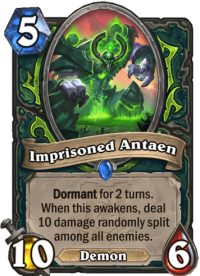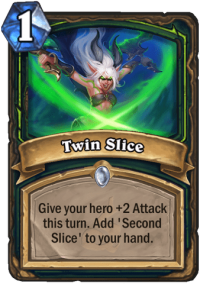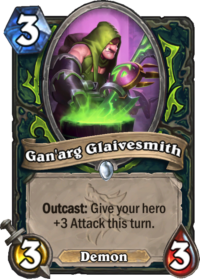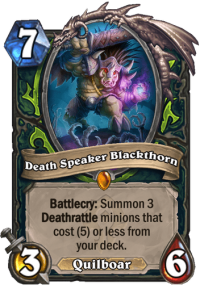Hearthstone’s tenth class is merely one year old at this point, and yet it’s already nothing like what it used to be at its launch. Beyond the power level realignment, which was more than necessary from a gameplay perspective, we’ve already seen Team 5 discard some ideas for Demon Hunter with what seems like a more coherent and balanced approach, with multiple interesting avenues to explore over the next few years.
Slice Me Nice

It doesn’t take much expertise to realize just how broken Demon Hunter was at the time of its initial release, with an unprecedented 24-hour window for an initial patch that targeted four different cards. It already marked the beginning of Demon Hunter’s reformation in a way: the nerf to Imprisoned Antaen and the subsequent change to Priestess of Fury basically ended the “splash damage at the end of turn” gameplay aspect for the class, which hasn’t been featured on any other card since and was a very strong curve-topper with a frustrating amount of randomness baked into it. It also encroached on the territory of Mage, whose such cards often have some sort of a combo aspect or can only target minions, a much weaker version of what Demon Hunter served up.
The first nerf also targeted two Outcast cards in the form of Eye Beam (initially cost 0 when played with Outcast) and Skull of Gul'dan (which, incredibly, launched with a cost of five mana). It became clear very early on that low-curve builds with rapid redraw options are very powerful, and the potential downside of these cards (namely that you need to cast it at their nominal cost as you don’t have the time to manipulate your hand spacing and composition) almost never come into play. This was also part of why Altruis the Outcast had to be bumped up to four mana shortly thereafter and how Crimson Sigil Runner lost half of its Attack value (which put it more in line with Novice Engineer in many ways).

Demon Hunter’s direct damage output, which amounted to a significant portion of its card pool, has also been culled over the months. The list makes for impressive reading: not counting the previously mentioned cards, we’ve seen adjustments to Glaivebound Adept, Twin Slice, Metamorphosis, Twin Slice, Kayn Sunfury and Warglaives of Azzinoth (which has partially been reverted for the Year of the Gryphon).
The change to Aldrachi Warblades, of course, had little to do with the extra two damage brought by the bonus durability point, but it also reflects how the class’ burn options were much more potent than initially assumed: it just provided way too much heal and survivability if you had three different opportunities to boost your Attack value before swinging with it. Just try and imagine Il'gynoth decks with this card in play in its original form and shudder – though it’s quite likely that somewhere in a dusty and half-forgotten PTR, they coexisted in peace during the early development phases of Madness at the Darkmoon Faire. We’ve seen other survivability tools affected as well, namely Blade Dance (which originally cost two mana) and Shardshatter Mystic (which began its life as a 3-mana minion).
By the time the sun set on the Ashes of Outland meta, 1/3 of the initial Demon Hunter cards have been nerfed by the developers. We’ve seen further changes made during Scholomance Academy as well, with Dreadlord's Bite quickly proving to be too powerful, alongside two other staple cards from the hyper-aggressive class build which dominated the meta at the time, bumping Voracious Reader to 3 and Lorekeeper Polkelt to 5 mana.
Now that we know what Demon Hunter isn’t anymore, it begs the question: what is it at this stage, exactly?
Illidan’s New Look

The Core set served as another opportunity for Team 5 to revamp the Demon Hunter gameplay experience as the Demon Hunter Initiate subset rotated out alongside the other Year of the Dragon sets. Of the 20 cards, only four made it through the gauntlet: Battlefiend, Feast of Souls, Eye Beam and Raging Felscreamer. Though this also reflects the initial design failures of the class, these remaining cards also serve as a good way to identify the suggested archetypes for Demon Hunter.
Hearthstone’s card design was always heavy on hand-holding and pre-baking archetypes like modern LEGO sets, and therefore these signposts are extremely valuable from an analysis standpoint. Demon tribal synergies saw occasional play with Raging Felscreamer but it seems to require oppressively powerful payoff cards like the original Priestess of Fury to make it work. All-out aggression with cards like Battlefiend will always remain the go-to approach for the class, and Lifesteal being a core part of Demon Hunter’s identity also ensures a framework for builds that go the long way. The inclusion of Feast of Souls suggests Team 5 would like to make a play for token decks in the class which seems like a lost cause so far.

The Forged in the Barrens class cards also suggest the potential emergence of a Deathrattle-based Demon Hunter synergy which sadly seems woefully weak so far. This might also turn out to be a bit like Druid’s… wait for it… barren spell of expansion cards due to their incredibly strong Classic set: “archetypes” like Beast Druid in GvG and some other dead-on-arrival approaches were purposefully weak or niche in nature as their evergreen options were more than potent enough to keep them relevant in the metagame. Demon Hunters might be experiencing something similar here, and may therefore have simply been shackled with a complement of crappy class cards for an expansion or two, rather than genuinely aiming to make Deathrattle summons a key part of its identity.
So where does all this leave the class going forward? At the time of writing, they’re seventh in the rat race with a 46.3% global winrate, sandwiched between Druid and Warlock shortly after the balance patch. Of course, global win rates aren’t a good way to measure the class’ precise power level, but they can still tell a story (like Paladin’s 57%+ WR at #1). Druid may not be a bad comparison in general: Demon Hunter has some baked-in advantages with its extra flexible hero power and a complement of relevant keywords (Outcast and Lifesteal) alongside strong weapons, which means it will likely stay afloat even when burdened by a bunch of poor cards. This, in turn, enables Team 5 to experiment with approaches like Deathrattle synergies, which is an important part of keeping its playstyle interesting over time. Though the balancing act wasn’t what we wanted it to be, Demon Hunter’s class identity is well-established at this point and it offers a unique gameplay approach. In that sense, Illidan’s arrival has been an unqualified success. We’ll just have to wait and see where future expansions take us.

Random question: Why are Altruis and Nethradamus the only Legends that show a ‘x2’ beneath it (at least in my collection)?
Regarding class identity: I think it’s very difficult for it to find it’s niche in a world of 9 other tried-and-true-classes (and even those have difficulties with their identity *coughpriestcough*). Demons is for Warlock, Tokens for Druid; Deathrattle for Hunter etc…
Actually the only niche not really dominantly occupied by other classes is Lifesteal. Imho that could be explored further. But a) it’s boring as f**k and b) it’s mostly som OTK stuff – which Blizzard doesn’t want to be too dominant.
Token…. the only time i made token succesfully with DH it’s in duel when i reach 12-1 with the new hero power.
If you want play token simply play druid, it’s the most cheap deck to reach legend i think.
Token should not be its class identity. This class has excellent board clears and that identity goes against token ideas. I understand zoo exists for warlock but we already have that established. DH might be best as a class that makes its hero continually attacking you. Also I continue to have tremendous fun with Big DH ever since the class existed. So glad PoF and IA did not rotate.
I think you misunderstand Token DH. I played it successfully (to Legend) all of last year. Token DH is not about building a board like other token decks. Most of their tokens are 1/1 with rush for reason: they are meant to die. The game plan of Token DH is to keep clearing the board until you are ready to drop your big bombs or hit with a large Wrathscale Naga attack. Unfortunately all the good payoff cards rotated, so the deck is no longer playable, but I will certainly be keeping an eye out for future synergy cards.
I have not looked at it this way. That’s because I don’t play any token or aggro decks. Thanks for the knowledge.
Blizzard need to rebalance all the weapons in HS I mean DH dreadlords bites a 3 mana 2 / 2 that only does something IF its outcasted just to do 1 damage to all minions which you can’t always outcast lol paladin has a 3 mana 3/2 weapon that gives you a card always and the 2 mana 1/2 that always puts a secret in play, I not a fan a huge fan of DH but I’d rather face aggro dh than secret paladin and mage, aggro dh without so many nerfs would be able to keep them in check.
This is more a case of Paladin previously being overtuned due to having a weak classic/basic set. On top of that, Paladin was pushed very hard over the last year due to having been weak before that. The result is that most of Paladin’s standard cards are now better than other classes’ average cards.
I would rather weapons were weakend in general unless we are given acess to better weapon control tools (preferably stuff that is usable in matchups against non-weapon classes)
Well I think that is the tech card issue. Secret tech is GREAT… and niche. Weapon tech is great… and niche.
Even in a meta like this, where Secret Pally (with weapons AND secrets), Warrior (with weapons), and Mage (with secrets) are by far the dominating forces, my control priest deck only has one weapon tech slotted. And, regardless of the power level of my deck going up, it feels awful to draw against non-weapon classes.
I don’t have a solution, but it’s an ongoing issue for me in the game. Like, drawing my Acidic Swamp Ooze can be a game-ender against Face Hunter. It is functionally a dead card, since most don’t run weapons, and I can’t waste 2 mana on a 3/2.
It’s hard to make powerful weapons without making weapon response cards, but it’s hard to make weapon response cards that don’t feel bad against non-weapon classes. It wasn’t as much of an issue last year, with the majority of control decks being Highlander. It’s easier to slot tech cards into a HL deck than a standard control one, because consistency in HL is more flexible.
All this to say, I wish I knew a solution to making tech cards feel better to play against the things they aren’t teched for.